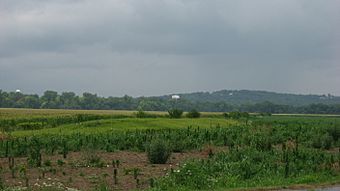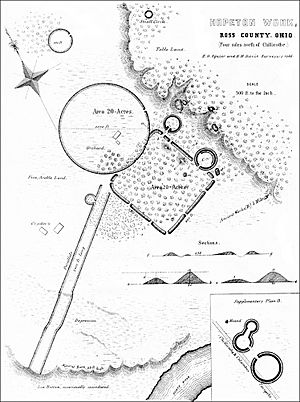Hopeton Earthworks facts for kids
|
Hopeton Earthworks
|
|

One of the few remaining walls
|
|
| Lua error in Module:Location_map at line 420: attempt to index field 'wikibase' (a nil value). | |
| Nearest city | Hopetown, Ohio |
|---|---|
| NRHP reference No. | 66000623 |
Quick facts for kids Significant dates |
|
| Added to NRHP | October 15, 1966 |
| Designated NHL | July 19, 1964 |
The Hopeton Earthworks are an amazing ancient Hopewell culture site. It's an archaeological site with cool mounds and earthwork walls. You can find it on the east side of the Scioto River. This is just north of Chillicothe in Ross County, Ohio.
The site is about a mile east of the Mound City Group. It's also near the Shriver Circle. Hopeton Earthworks is part of the larger Hopewell Culture National Historical Park. Other parts include the Mound City Group, Hopewell Mound Group, Seip Earthworks, Spruce Hill Earthworks, and the High Bank Works. Good news, this site is open for everyone to visit!
Contents
Exploring the Ancient Earthworks
Who Explored Hopeton?
Two important people, Ephraim George Squier and Edwin Hamilton Davis, visited Hopeton in 1846. They were like ancient detectives! They wrote about what they found in their 1848 book, Ancient Monuments of the Mississippi Valley.
They described the site as having a main part and some smaller sections. The main part included a rectangle shape. It also had a large circle attached to it. This circle actually went inside the rectangle, which was a bit unusual.
What Did Squier and Davis Find?
The rectangle was huge, about 950 feet (290 meters) long and 900 feet (274 meters) wide. The attached circle was even bigger, about 1,050 feet (320 meters) across.
They found 12 openings or "gateways" in the walls. Each gateway was about 25 feet (7.6 meters) wide. A long wall, about 530 feet (162 meters) long, connected the circle to the rectangle.
On the east side of the earthworks, there were two more circles. One was about 200 feet (61 meters) wide, and the other was 250 feet (76 meters) wide. Another small circle was just north of the site, also about 250 feet (76 meters) wide.
The Amazing Walls
The walls of the earthworks were made of loam, which is a type of soil. They were very tall, about 12 feet (3.7 meters) high. At the bottom, they were about 50 feet (15 meters) wide!
Unlike many other ancient walls, these didn't have a ditch next to them. Squier and Davis were very impressed by how big and strong the walls were. They said the walls looked like the "heavy grading of a railway". They were even wide enough for a coach (like an old bus) to drive on top!
The walls of the circles were a bit shorter than the rectangle walls. Squier and Davis thought this might be because of farming over the years. They also noticed that the clay used to build the circle walls was different colors. This was different from the natural earth around them.
Other Discoveries
Squier and Davis also mapped out parallel walls. These walls went from the northwest corner of the rectangle towards the river. They were about 24 feet (7.3 meters) long and 150 feet (46 meters) apart. These walls ended at the edge of a high area, where the river used to flow.
They also found some holes where soil had been removed. However, these holes were not big enough to have created all the earthworks. At that time, they didn't find any large mounds. But they did discover two small oval-shaped bumps. There were also two small mounds inside the rectangle.
After their careful study, Squier and Davis believed that the Hopeton Earthworks were used as a fortification. This means they thought it was a kind of ancient fort!


